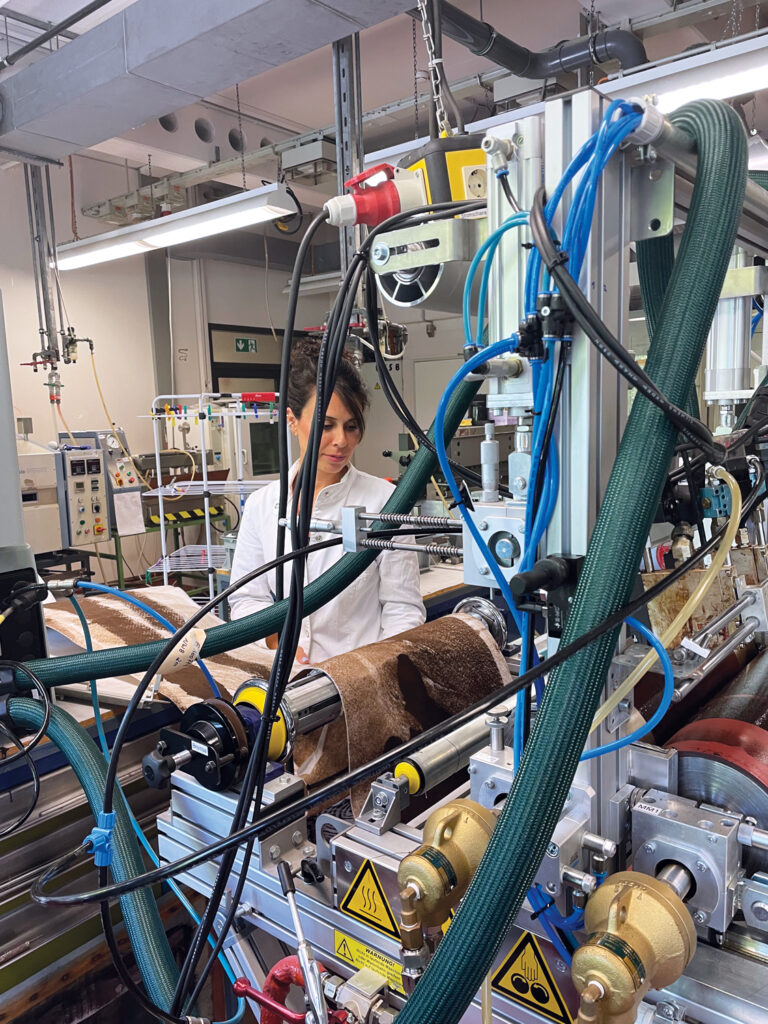
A political, economic, social, technology (PEST) analysis on the smart and advanced textile industry for 2023 would likely show that “P” dominated, as politics has affected all sectors. But that is not to diminish the important developments that have taken place in the industry, in some cases because of the conflicts and in others despite them.
PEST itself is being revised to reflect the importance of environmental issues so that many are now looking instead at a social, technological, economic, ecological and political (STEEP) analysis, which will undoubtedly figure into a 2024 year in review.
Biotechnology
In 2022 enthusiasm for biopolymers was tempered by issues around scalability, standardization of products, quality control and ensuring the reliability of supplies. But progress was made in 2023. An interim solution has been found in the use of the material as a coating on natural fibers, so that, although it’s a hybrid, it retains environmental credentials.
The German Institutes of Textile and Fiber Research Denkendorf (DITF) is using lignin as a bio-based coating to protect and extend the longevity of natural fibers in geosynthetic applications. Toray Carbon Fibers Europe has started the manufacture of recycled carbon fiber (rCF) that is derived from recycled raw materials and biomass.
The rCF is based on a pyrolysis recycling process and, in cooperation with technology company Lenovo, it’s being used as a reinforcement filler for thermoplastic pellets for the Lenovo ThinkPad X1 Carbon Gen 12 ultralight laptop.
Recovering carbon fiber from composites and diverting it from landfills and into high-value products is an example of what’s possible. It’s also a case study in bringing multiple stakeholders together from very different markets.
Trends in 2024 and beyond
Trends in the textile industry are not easy to pin down; market researchers agree on some but not all. However, some big-picture trends have already emerged in 2024.
- The wide-ranging issues surrounding sustainability
- Novel materials
- Smart textiles’ slow but consistent growth
- Prospects for artificial intelligence (AI) in the advanced textile industry
Redefining sustainability
What it means for a business or product to be “sustainable” is a complex question. Recycling, water use, energy use, harmful chemicals, waste generation, supply chain, and landfilled single-use products are among the basic issues facing producers every day.
StartUs Insights, which provides industry research services, chose “sustainable supply chain” for the number 4 slot on its “Discover the Top 8 Trends in the Textile Industry (2024)” list. It also says that the textile industry is “one of the largest contributors to environmental pollution.”
Textile enterprises often turn to services, such as those provided by many research firms and academic institutions, to help them navigate the process of supply chain due diligence. According to the German research and testing company Hohenstein, due diligence means that a company is responsible for protecting human rights and the environment throughout its supply chain, encompassing its business partners’ operations as well as its own.
The industry also continues to struggle with the recycling of textile waste and discarded textile products. TheRoundup.org, a website dedicated to promoting environmental awareness and sustainability, published an article on April 11, 2023 (“17 Most Worrying Textile Waste Statistics & Facts”) that lists several key points, including that the world produces 92 million tons of textile waste every year. Furthermore, 87% of the materials and fibers used to make clothing alone will end up either in incinerators or landfills, and only 20% of discarded textiles are collected.
To curtail “greenwashing,” the European Parliament recently passed a directive to regulate labeling. SportsTextiles.com reported on the EU’s directive that aims to “make product labeling clearer and more trustworthy” by banning the use of general environmental claims (environmentally friendly, natural, biodegradable, climate neutral or eco) without providing proof.
Novel materials
StartUs Insights, which identifies the industry’s main environmental issues as water and air pollution, greenhouse gases, and chemical discharge, says that “novel fabrics and advanced manufacturing technologies are major textile industry trends.” In fact, it put the development of novel textiles at the top of its trends list largely because of these environmental issues.
Artificial intelligence
At this point, the big question is where, exactly, AI will take hold first within the larger textile industry. With a chronic shortage of trained and experienced employees, AI technology could help to bridge that gap. It could help speed up the product development process from design through prototyping to scaling up production.
MarketsandMarkets calls artificial intelligence a “megatrend” in a white paper accessible via its website. It identifies AI as “the primary driver of growing technologies, such as robotics, big data, and IoT [the Internet of Things]. … AI has the potential to add value to business workflows, augment employee capabilities and harness the power of man and machine to improve customer experience.”
Marie O’Mahony, Ph.D., is an industry consultant, author and academic based in London, England.
Janet Preus is senior editor of Textile Technology Source. She can be reached at janet.preus@textiles.org.
 TEXTILES.ORG
TEXTILES.ORG


